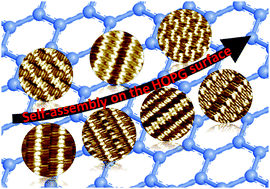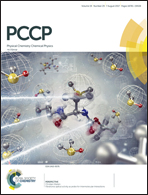Two side chains, three supramolecules: exploration of fluorenone derivatives towards crystal engineering†
Abstract
Structural diversity obtained through two-dimensional molecular self-assembly induced by the chain length effect has gained immense attention, not only because of its significance in crystal engineering but also for its potential application in nanoscience and nanotechnology. Three kinds of fluorenone derivative, named F-C7C7, F-C14C7, and F-C14C14, were synthesized and used for systematic exploration of their crystalline difference. At first, scanning electron microscopy and X-ray powder diffraction were performed to investigate their differences in morphology and three-dimensional crystal structure. Then scanning tunneling microscopy experiments were conducted to compare the self-assembled monolayers. Moreover, different solvents were used to repeatedly investigate the occurrence of structural diversity. F-C7C7 could not self-assemble into a stable monolayer on the graphite surface under ambient conditions due to its weak molecule–substrate interaction. F-C14C7 was observed to self-assemble into twist, plier-like, octamer-curve, and random structures in 1-octanoic acid, 1-phenyloctane, n-tetradecane, and dichloromethane, respectively. However, when the same solvents were used and at similar concentrations, the F-C14C14 molecules were arranged into interval, mixed, linear, and plier-like configurations. These self-assembled nanopatterns formed under the driving forces of dipole–dipole interactions, hydrogen bonds, and chain–chain, molecule–substrate, and molecule–solvent van der Waals interactions. Furthermore, from the viewpoint of thermal analysis, differential scanning calorimetry, as well as polarized optical microscopy, was performed to further elucidate the difference between these three compounds in the solid and liquid crystal states. The present system is believed to provide understanding of how the chain length effect induces different crystalline properties, and to open up the possibility of fabricating diverse self-assembled networks for crystal engineering.



 Please wait while we load your content...
Please wait while we load your content...